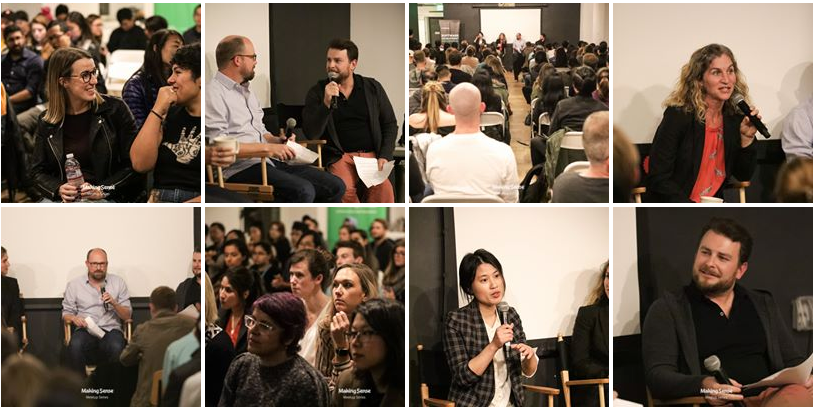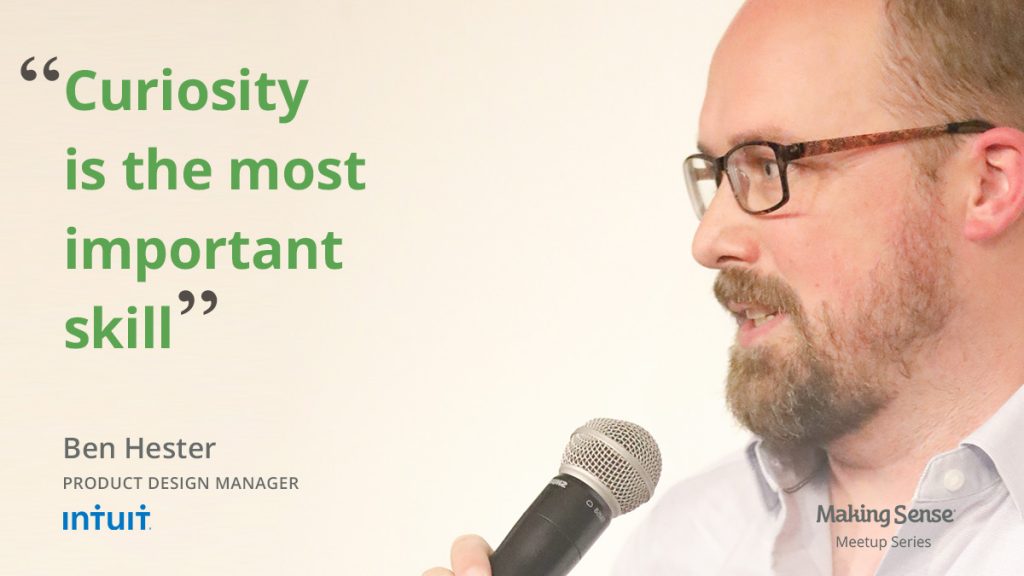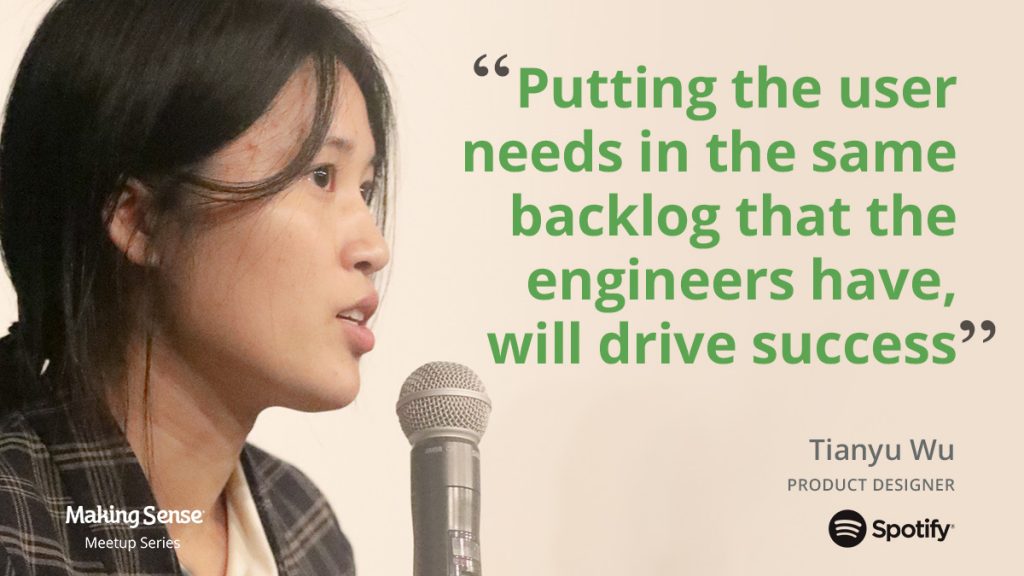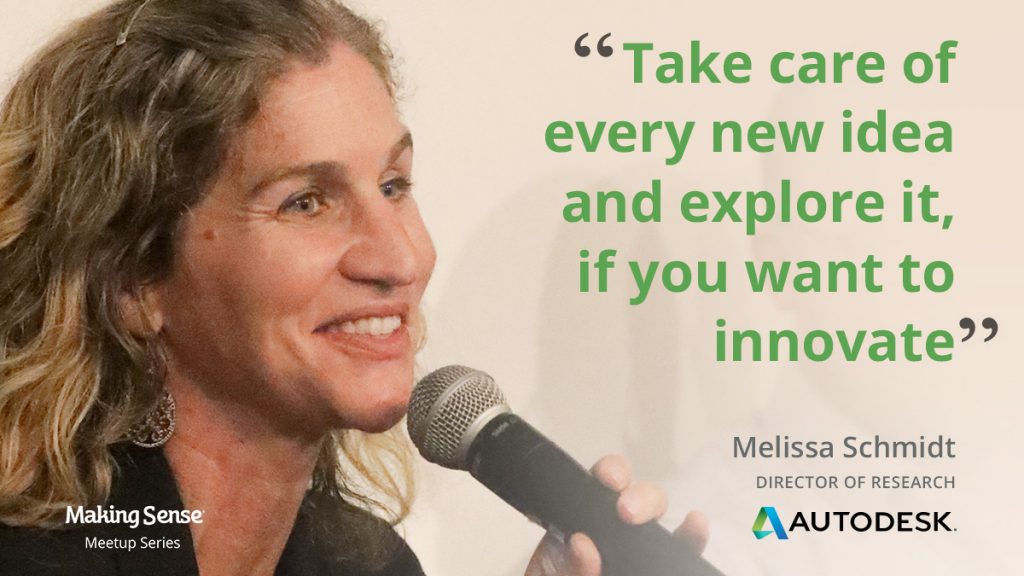We talk a lot about Design Thinking around here at Making Sense. So it was nice to hear what others have to say about a topic that’s so important to us. When we asked experts from these three companies, known for innovation, to weigh in on what makes companies great, we heard a lot about Design Thinking.
If you’re looking to spark innovation at your company, there was a lot of good advice coming out of our latest Meetup hosted in General Assembly, San Francisco.
Here’s a recap. In the meantime, take a look at the photos and tag yourself if you appear!
The Benefits of Having Company-Wide Alignment to Design Thinking
Designers are typically well-versed in the principles of Design Thinking. But what we learned from our three panelists was that it’s key to have everyone, not just the development team, vested in this popular approach to problem-solving. That includes people from your executive suite, the front line staff, and your administrative departments — when everyone is aligned with the principles of design thinking, companies have a great foundation for making innovation happen.
At Intuit, for example, design thinking is embraced at every level. Design “comes from the top”, it’s embraced early on, and it’s part of every employee’s onboarding — even support people. It’s what has helped the company not just innovate but continue to innovate over time.
Digging deeper, company-wide alignment to design thinking also means you can innovate better, too. It allows you to “democratize research” – in other words, tap into everyone’s passion, not just a select few on the development team, whose job is to think innovatively or perform user research. Democratizing research means you can actually go beyond what researchers can offer you for developing your product, according to Melissa Schmidt, our panelist from Autodesk.
Having the mindset to do all this is based on removing any fixed notions of what people can do and offer. Everyone of us has a set of valuable skills and passions that we can bring. If someone is passionate about customers, it doesn’t matter what department they work in. Intuit’s Ben Hester, for example, was given a chance early on in his career when he created the job description for a product manager at his company and they went for it, even though it was a totally new concept for them.
Innovation: What Does it Take? Curiosity, Adaptability, Collaboration, Relentlessness, Empowerment
Of course, company culture is unique to every workplace and not all are set to handle design thinking on the same level as Intuit, Spotify, and Autodesk. What does it take to achieve innovation on a company-wide level and incorporate design thinking? If there’s a common thread that runs among the people who make innovation happen at the world’s cutting-edge companies, it’s the following set of traits.
Curiosity. One thing that helps companies implement design thinking is to have people on board who have curiosity and passion.
The world is moving incredibly fast, making it even more crucial that people stay curious. But defining curiosity is also key: it’s not just that you need to have curiosity about your users. It’s a larger sense of the word, where you have curiosity about the people you work with and also what makes them tick. And it’s also curiosity about the tools that you use.
Adaptability. Another thing that’s essential is adaptability. Curiosity about the tools that you use becomes a constant quest to find the right tools, a willingness to break the rules, and an instinct not to rely on how others have done it before you. Innovation happens when people go out and find better ways, new ways to do things. The world is always changing, so continually sticking to the rules on how things have always been done isn’t going to lead to the highest levels of innovation.
Being adaptable also means practicing both divergent and convergent thinking. It’s about being ready to learn what the next thing is rather than mastering one single hard skill or technology.
Collaboration. The ability to collaborate with people who speak another language is crucial to innovation. And by “another language”, we mean the languages of different technologies, other businesses. It’s the ability to work across disciplines that is one of the most critical skills for success.
Relentlessness. And in general, never rest on your laurels. Never sit on your success and always be looking for how you can continue to live the culture of design thinking.
Empowerment. Finally, empower young designers to have a voice in the company. You have to nurture new ideas, let them exist, explore them if you want to innovate.
What Can You Do for a Better Practice Using the Design Thinking Approach?
There are a lot of ways to encourage Design Thinking at your own company, no matter what your company is like.
You can even bring Design Thinking to your company yourself through workshopping, and then sharing what you learn with others. In fact, there are a lot of small ways you can help out. You could even hold your own workshops, letting people get hands-on experience with divergent exercises and convergent thinking by using storyboarding, etc to get a feel for it all.
Secondly, practice making “leap of faith assumptions”. At Intuit, after talking with users, they ask questions like:
- What did we learn?
- What kinds of assumptions do we think we can make about the future for our product based on what we learned?
- What kinds of experiments can we do to incrementally work our way toward those assumptions?
That future vision might change as time goes by. Bottom line: push to imagine the future instead of reacting.
Going above and beyond that, keep in mind that research, no matter how beautiful it may be, doesn’t do it all. But if you’re aligned from the beginning, with what your PMs are trying to solve, it can be like magic and it can be a beautiful partnership, as Melissa Schmidt put it.
In other words, all this lets you tap into the latent needs that the customers are not telling you but which you are observing. That is what Design Thinking is all about, and where innovation starts.
Cheat Sheet Takeaway: A Design Thinking Checklist of Things to Do
In addition to all this great advice on Design Thinking, here’s a cheat sheet of tips from our three experts on what you can do to promote a culture of design thinking at your company:
- Lead by influence rather than authority
- Be a community builder
- Give the tools for brainstorming
- Bring your own energy and passion for design everywhere you go at work
- Always find ways to keep the conversation about design alive
- Visit the kinds of customers you’re trying to understand. Observe how they work and how the products integrate into their lives
- Build “Psychological Safety”: do informal critiques on all teams and work on creating a healthy environment for that.
- Help your company understand how design maps to its business goals
- Practice “leap of faith assumptions” about your product, based on what you learn about your customers
- Make good design a corporate goal from the executive level
- Get metrics that give you focus for seeing the whole picture
- If you get paraylzed, ask more questions
- Have the team go through the experience that you’re trying to improve
Thanks for Joining Us!
Once again, what a great Meetup. Everyone had fun and learned a lot and it seems our Meetups just keep getting better and better. That’s the final one for this year. We hate to have them end but there will be more next year, to be sure. In the meantime, as we move into the holidays and the new year, stay with us right here for more updates and next year’s schedule.
See you next time, and thanks a million to our three great panelists, who helped us close out this year’s Meetup calendar with a bang!
Of Course, in case you missed it or you want to recall what happened at the last UX Intimate Session of the year, here is the video!




